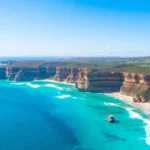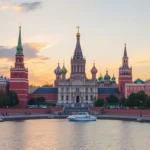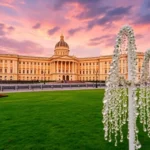10 Things to See in Moscow's Red Square: History and Facts
- 1. The Cathedral of St. Basil: The Crown Jewel of Red Square
- 2. The Monument to Minin and Pozharsky: A Symbol of Resilience
- 3. The GUM Department Store: Luxury Amidst History
- 4. The Cathedral of Kazan: A Hidden Gem
- 5. The Resurrection Gate and Iberian Chapel: Architectural Elegance
- 6. The State Historical Museum: A Journey Through Time
- 7. The Tomb of the Unknown Soldier: A Touching Tribute
- 8. Lenin's Mausoleum: A Historical Enigma
- 9. The Necropolis of the Kremlin Wall: Final Resting Place of Legends
- 10. The Kremlin: More than Meets the Eye
- A Map of Red Square, Moscow
When one thinks of Russia, the image that often comes to mind is that of the majestic Red Square in Moscow. This iconic landmark is not just the heart of Moscow but also a canvas painted with centuries of history, culture, and unforgettable moments. Whether you’re visiting for the first time or returning to soak in its allure, the Red Square promises an experience that resonates deeply with every traveler. Are you ready to explore the treasures that await?
Let’s start with a fascinating fact: the name “Red Square” doesn’t derive from the color of the buildings or the association with communism, as many might think. Instead, it originates from the old Russian word Красная (krásnaya), which once meant “beautiful.” Thus, the Red Square is, in essence, the Beautiful Square. And beautiful it certainly is!
1. The Cathedral of St. Basil: The Crown Jewel of Red Square
No visit to Red Square is complete without marveling at the Cathedral of St. Basil, a true architectural wonder and one of the most recognizable symbols of Russia. Built between 1555 and 1561 under the orders of Ivan the Terrible, this cathedral was erected to commemorate the conquest of the Khanate of Kazan.
Legend has it that upon completion, Ivan the Terrible asked the architect whether he could create another such masterpiece elsewhere, to which the architect replied in the affirmative. In a fit of paranoia, Ivan ordered that the architect be blinded to ensure that he could never replicate its beauty. Whether this tale is factual or merely a myth, it adds to the mystique surrounding this enchanting structure.
Visitors eager to explore the interior must pay an entrance fee of 500 rubles, but many guides suggest that the real magic lies outside, with its vibrant, bulbous domes resembling an ice cream cone of colors. For those with a keen interest in history, the cathedral even makes a cameo in the renowned video game Tetris, invented by a Russian!
For an enriching experience, consider joining a free tour starting from the square, which can be booked in advance. Although it’s complimentary, it’s customary to tip your guide at the end.
2. The Monument to Minin and Pozharsky: A Symbol of Resilience
Standing proudly in front of the Cathedral of St. Basil is the Monument to Minin and Pozharsky, a powerful tribute to the two leaders who rallied a volunteer army to expel Polish-Lithuanian invaders in the early 17th century. This moment was pivotal in Russian history, marking the end of the tumultuous period known as the Time of Troubles.
Originally located near the GUM department store, the statue was relocated during Stalin’s era for military parade purposes. Luckily, it was preserved during a time when many historical structures faced destruction.
3. The GUM Department Store: Luxury Amidst History
Interestingly, right in the heart of Red Square lies the opulent GUM Department Store. It’s a striking contrast to the area’s historical significance, showcasing luxury shopping in a space that once served as a hub for communist leaders. While indulging in a shopping spree may not be feasible for everyone, wandering through its lavish corridors is a must. You’ll find a variety of traditional Russian products, including chocolates, vodka, and, of course, caviar!
The GUM was constructed in 1893, but its history stretches far beyond retail. During the Soviet era, it was repurposed as offices for high-ranking party officials. Amongst the upscale boutiques, you can find affordable eateries, such as Stolovaya 57, where you can sample traditional Russian dishes. Don’t miss trying the famous ice cream sold at various stands for just 100 rubles!
As night falls, GUM transforms into a dazzling spectacle. Its festive lights create a magical atmosphere, capturing the spirit of the square.
Just past the GUM lies the Cathedral of Kazan, notable for its soft pink hue. Many visitors may overlook it, drawn instead to St. Basil’s flamboyance. However, the Cathedral of Kazan is a surprising delight, showcasing stunning architecture. Unfortunately, during our visit, it was undergoing renovations, leaving us to admire its exterior.
Interesting fact: In 1936, Stalin ordered the demolition of churches across the nation, but the Cathedral of St. Basil was the sole structure to escape this fate. As a result, Kazan’s cathedral is a reconstruction of the original.
5. The Resurrection Gate and Iberian Chapel: Architectural Elegance
The Resurrection Gate is the most picturesque entrance to Red Square. This double-arched gateway, like the Cathedral of Kazan, was also destroyed during Stalin’s regime and has since been rebuilt. The gate features two towers topped with pointed octagonal roofs, while a charming chapel houses a replica of the icon of “Our Lady of Iveron” from Georgia.
Just outside the chapel, a small golden plaque marks KM 0, similar to the famous Plaza del Sol in Madrid.
6. The State Historical Museum: A Journey Through Time
If you have a passion for history, the State Historical Museum is a treasure trove waiting to be explored. With an entrance fee of 500 rubles, you’ll gain access to millions of artifacts narrating the evolution of Russian history and culture. Opened in 1883 during the reign of Tsar Alexander III, the museum itself is an architectural marvel.
Tip: Consider renting an audio guide for a more immersive experience, and don’t forget: it’s closed on Tuesdays!
7. The Tomb of the Unknown Soldier: A Touching Tribute
As you pass through the Resurrection Gate and turn left, you’ll find yourself at the Tomb of the Unknown Soldier. This poignant memorial honors the millions of Soviet soldiers who perished during the Great Patriotic War (the Russian term for World War II). The tomb is guarded by soldiers, and the changing of the guard occurs every hour.
Inscribed on the tomb is a bronze star that houses an eternal flame, with the inscription “Your name is unknown, your feat is immortal” adorning the monument.
8. Lenin's Mausoleum: A Historical Enigma
Another fascinating site in Red Square is Lenin's Mausoleum, where the embalmed body of Lenin, a significant figure in Russian history, is displayed. To visit, you’ll need to queue, leave your phone at the entrance, and proceed quickly past the tomb, removing your hat and keeping your hands out of your pockets. Admission is free, but it’s only open from 10 AM to 1 PM, excluding Mondays, Fridays, and Sundays. Expect to wait about an hour in line.
Interestingly, Lenin’s last wish was to be buried in his beloved St. Petersburg beside his mother. However, Stalin chose to create this mausoleum for public homage, turning it into a propaganda tool that continues to attract thousands.
9. The Necropolis of the Kremlin Wall: Final Resting Place of Legends
Just behind Lenin's Mausoleum lies the Necropolis of the Kremlin Wall, where the remains of notable figures such as Stalin and Yuri Gagarin are interred. This is the only place in Moscow where a bust of Stalin can be found, reflecting the period of “de-Stalinization” that followed his death.
A notable American, journalist John Reed, who chronicled the October Revolution, is also buried here, showcasing the intersection of Russian and American histories.
10. The Kremlin: More than Meets the Eye
No exploration of Red Square would be complete without a visit to the Kremlin, a symbol of Russia's political power. Contrary to popular belief, the Kremlin is not just the seat of government; the term “kremlin” means “fortified city” in Russian. Within its walls lies a complex of stunning cathedrals, palaces, and museums, including the Armory, known for its collection of gold, crowns, Fabergé eggs, and historic weaponry.
There are two separate entrances: one for the Cathedral Square (700 rubles) and another for the Armory Museum (1000 rubles). Tickets can be purchased online or at the Alexander Gardens on the day of your visit. Joining a guided tour in Spanish is a fantastic way to maximize your experience and avoid long lines.
Pro tip: The Kremlin is closed on Thursdays. And while you can’t visit the Russian government itself, you can learn more about Putin's figure from the official website.
Fun fact: There are many kremlins across Russia, and even in Moscow! The Izmaylovo Kremlin is another fascinating site to explore.
Here are a few interesting facts about Red Square:
- The date of May 9 is significant for Russians, as it marks the annual Victory Day parade, commemorating the end of World War II (the Great Patriotic War).
- Red Square spans over 24,000 square meters and is restricted to pedestrian traffic and military vehicles only. Despite its size, it is not among the largest squares in the world.
- A bizarre event occurred on May 28, 1987, when a small plane landed in Red Square, piloted by German Mathias Rust, who evaded Soviet air defenses, leading to significant political repercussions.
Curious to learn more? Check out this video for a deeper dive into the history and culture surrounding Red Square:
A Map of Red Square, Moscow
Here’s a handy map marking all the key sites to see in Red Square, making your exploration easier and more enjoyable.
As you wander through this beloved square, take a moment to appreciate both its beauty and its monumental history. Have you discovered more things to see in Red Square? Share your experiences and insights with us!






Deja una respuesta